A subcutaneous abscess is a local infection caused by pathogenic bacteria. Due to the emergence of multidrug-resistant (MDR) pathogenic bacteria, there is an urgent need for the development of new approaches to treat subcutaneous abscesses. In recent studies, we determined that ruthenium nanoparticles have high photothermal conversion efficiency and can transfer energy to surrounding oxygen molecules to generate cytotoxic singlet oxygen (ROS). Acetylcholine (Ach) was modified and added to the surface of the ruthenium nanoparticles to form composite nanoparticles (Ach@RuNPs). Acetylcholine played a role in targeting the nanoparticles on bacteria, and promoting their entry into the bacterial cells as determined by bacterial plate assays. Experiments using a mouse subcutaneous abscess model also showed that Ach@RuNPs were targeted on bacteria. Upon irradiation with an 808 nm laser, Ach@RuNPs could function as both a photodynamic therapeutic (PDT) and a photothermal therapeutic (PTT) agent to kill pathogenic bacteria, and repair infected wounds without leaving residual implanted materials. The use of Ach@RuNPs represents an attractive potential treatment approach for subcutaneous abscesses due to their high efficacy and minimal invasiveness.

Effective PDT/PTT dual-modal phototherapeutic killing of pathogenic bacteria by using ruthenium nanoparticles
Review badges
0 pre-pub reviews
0 post-pub reviews